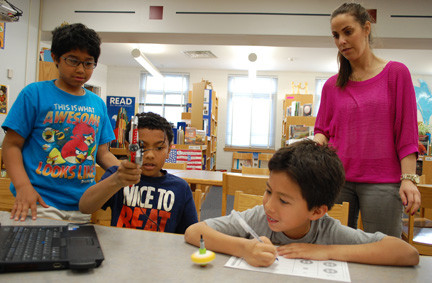Legos become latest learning tool
It’s not often that students get to come to school and play with Legos, especially in an era of high-stakes testing. But in District 30, the popular building toy is being tried out as a learning tool and the feedback so far has been glowing.
“Most students are definitely familiar with Legos,” said Ilissa Epstein, the district’s Quest teacher. “Most of them have them at home but most of the students didn’t realize how much they can actually do with them.”
Epstein is testing out a Lego robotics programs with children in the district’s enrichment program. The fourth-, fifth- and sixth-grade students get to hone their science, technology, engineering and math skills. Additionally, one teacher at Clear Stream Avenue school is using the program, and a Lego Club has been launched at Forest Road School.
Gerard Poole, the assistant superintendent for curriculum and instruction, said he was aware of other districts using the Lego robotics program and did more research on it. What he found was a program that engaged students and allowed them to hone their skills in several subject areas.
The program, which includes Lego kits and software, was funded through a performance grant the district was awarded, which will pay it $600,000 over three years. The grant stipulates that the money has to be used to enhance opportunities for students.
Epstein said she is glad to have Lego robotics as one of the new initiatives in the district. She explained that it not only has students working in a hands-on manner, but it has them working together to solve problems.
“We have to trust each other,” said fourth-grader Pablo Pazmino, adding that if a classmate has a different idea on how to build something, they have to talk it out to reach a solution.
Since the Lego robotics program was introduced in March, the students have worked on many different projects. They made a drumming monkey and learned how to use computer software to modify the pace of the beat. They also built a top and learned how different size gears can affect how long the top will spin.
The software gives students step-by-step instructions of how to build certain projects, but others are up to their imaginations. Students have to use the scientific process by making guesses, observing and drawing conclusions.
They also have to learn how to follow directions. Epstein said one Lego placed in the wrong spot can affect the entire outcome of a project.
Getting the program started required a lot of work, Poole explained. Teachers needed to be trained, kits purchased and software set up on computers. However, he said, the effort was worthwhile. “It’s not an easy thing to implement,” he said. “We’re in a great spot right now. Learning is taking place. I’m really excited about it.”
Fourth-grader Erick Garay said the way he gets to use Legos in school is something he never would have thought of on his own. “You’re making it move instead of just building it and moving it yourself,” he said. “It’s like a whole new world. It’s weird, Legos combined with computers.”
Epstein said that having students learn through hands-on experiences is education at its finest. “They’re learning and having fun at the same time,” she said, “and that’s what teaching is all about.”

 50.0°,
Overcast
50.0°,
Overcast 




